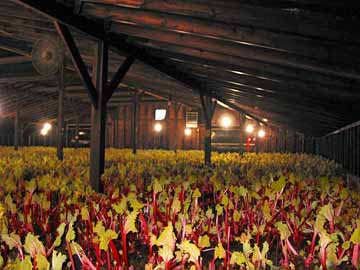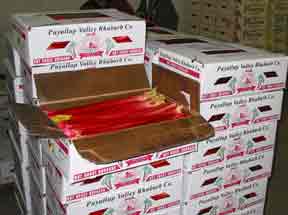Memories of Rhubarb
by Jerry Bates
South Hill doesn’t necessarily come to mind when thinking about rhubarb. The valley areas around Puyallup and Sumner have been and continue to be the leading producers of rhubarb in the United States, but did the farmers of old South Hill ever get involved with this crop commercially?

The Puyallup Valley Rubarb Co. rhubarb hot house.
Members Don Glaser and Bill Goelzer, life-long residents of the hill can easily remember when small farms dominated the lives of those who lived here, long before shopping malls and housing developments. They both recall a time when commercial rhubarb farming did exist on South Hill.
Don Glaser, SHHS Vice President, recalls a period during his childhood from about 1935 to 1943 when his grandfather owned and operated a rhubarb farming business on property next to where Don’s family lived. Don’s grandfather, Joe Glaser, farmed on forty acres located on the corner of today’s 144TH St. E and 122nd Ave E (Glaser Road). The ranch had 150 fruit trees, also raspberry fields, in addition to the 10 to 15 acres of rhubarb. The present-day pond that can be seen from 144th was, back then, drained by a long ditch the Glasers dug across their property, exposing rich peat soil where the rhubarb was planted.
In addition to the rhubarb fields, five rhubarb hot houses were built. The hot houses were windowless structures approximately 15 by 80 feet with walls low to the ground and a roof peak reaching about ten feet. The rhubarb started out growing in the field for two summers before it was ready for the hot house. Don remembers the hard work involved harvesting the rhubarb root balls. A single blade, horse-drawn plow would turn the roots up. Then Don, as a child among the farm hands, would lift the heavy root balls into a waiting wagon. The roots would be planted in the hot house. After two months they were ready to be harvested. The hot house was heated during the winter growing months, using 55-gallon oil drums made into wood stoves. The result of all this effort was hot house rhubarb, much superior to the field grown variety. Hot house rhubarb has a 50% greater sugar level, and is more tender, therefore making better pies and preserves. Don and the Glaser family members would harvest the ripe rhubarb using a long sharp knife, one swipe to cut off the root and a second to remove the leaves.
Don’s grandfather sold the ranch and retired from farming between 1948 and 1949.
Member Bill Goelzer remembers…..
My dad, Les Goelzer, was a farmer on South Hill. He grew daffodils, strawberries, and Christmas trees. He didn’t grow rhubarb, but he did sell it by the train boxcar load. He shipped Christmas trees to the San Francisco Bay area in November and December. Our family stayed home through January and February while dad sold rhubarb in San Francisco. The Sumner Rhubarb Exchange shipped the stuff by the boxcar loads to California. It was packed in 20 or 30 lb. crates, and my dad got five cents a crate commission for selling it. This was in the late 30’s and early 40’s when the Puyallup Valley, Sumner, and Alderton had long black sheds everywhere. These sheds had dirt floors and a large door on each end so a farm tractor and trailer could travel all the way through. The growers dug the rhubarb root balls out of the field and transported them to these “hot houses.” The sheds were heated by stoves, sometimes made from 55 gallon oil drums, and fueled by kerosene, diesel, or used crankcase oil. This forced an early crop of rhubarb which was called “hot house” rhubarb. After this early season, the rhubarb plants sometimes were returned to the fields to rest for a couple of years to get their strength back before returning to the hot house. I’ve had rhubarb plants for over 30 years, and they’re still producing. Rhubarb is good for sauce, pies, and as a filler for jams. It also makes a wonderful wine, but don’t eat the leaves – they’re poisonous.
Hot house rhubarb today?
Don Glaser has often wondered if there is a local source for hot house rhubarb he so fondly remembers from his youth. He called me last March, thinking he might have found a grower. While traveling across the valley floor through the farmland along Riverside Road East, Don noticed what looked like rhubarb hot houses and rhubarb roots piled high outside—could this be rhubarb hot house farming?
Days later, Don and I went exploring around this area. We drove by the Knutsen Farms Inc. complex, circled around and visited the business office. Sure enough, besides commercially growing flowers, Knutsen Farms Inc. are commercial growers of hot house rhubarb, known as the Puyallup Valley Rhubarb Co. Don managed to persuade them to give us a tour a few weeks later. During our tour we were given some free rhubarb to take home, thanks to our guide. Don’s wife Mary made good use of our haul, baking pies and making preserves. She rewarded this writer with a home made pie and a jar of preserves. Don’t expect to buy rhubarb from the farm, it’s not distributed to the public, nor will you find any of the Knutsen crop at local Grocery stores, all their rhubarb is exported to California and the East Coast.

Ready to be shipped, Puyallup Valley Rhubarb Co. hot house rhubarb
On the hill today rhubarb exists in back yard gardens only, but in days past, besides trees, berries, hops, rabbits and chickens, let’s not forget to add rhubarb as a product of old South Hill.